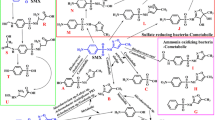Abstract
Two chromium(VI) resistant yeast strains (Candida sp. andRhodosporidium sp.) were isolated from industrial wastes. Four different yeasts, three from the Industrial Yeast Collection and one of pharmaceutical origin, were also studied in relation to chromate toxicity and its alleviation by sulfur species. The growth of yeasts from industrial wastes was inhibited by 50% by high concentrations of Cr(VI):Candida sp. by 4mm Cr(VI) andRhodosporidium sp. by 10mm Cr(VI) in Sabouraud Broth medium. The other Cr(VI)-sensitive yeasts were inhibited by 0.1mm Cr(VI). The general mechanism of chromium resistance inCandida sp. andRhodosporidium sp. was due to reduced uptake of chromium, but not to biological reduction from Cr(VI) to Cr(III). In Cr(VI)-sensitive yeasts, chromium was accumulated as much as 10-fold, as inSaccharomyces cerevisiae. Cr(VI) toxicity inCandida sp. was modulated from Cr(VI)-resistance to Cr(VI)-hypersensitivity depending on the addition of methionine, cysteine, sulfate and djenkolic acid. IfCandida sp. was grown in the presence of S-amino acids, especially methionine, it was more resistant than if the sulfur source was sulfate. When sulfate transport was enhanced by addition of djenkolic acid,Candida sp. became hypersensitive.Rhosporidium sp. was always resistant to Cr(VI) because sulfate transport was inefficient and it assimilated sulfur as S-amino acids. Cr(VI)-sensitive yeasts required larger amounts of S-amino acids, especially methionine, to tolerate Cr(VI) toxicity. Cysteine was toxic forC. famata 6016 above 50 μm,
Similar content being viewed by others
References
Aislabie J, Loutit MW. 1984 The effect of effluent high in chromium on marine sediment aerobic heterotrophic bacteria.Marine Environ Res 13, 69–79.
Baldi F, Vaughan AM, Olson GJ. 1990 Chromium(VI)resistant yeast isolated from a sewage treatment plant receiving tannery wastes.Appl Environ Microbiol 56, 913–918.
Baldi F, Pepi M. 1991 Study of metal and non-metal resistances in chromate-resistant yeasts isolated from industrial wastes. In: Verachtert H, Verstraete W, ed.Proc Int Symp on Environmental Biotechnology, Ostend, Belgium; 1: 255–258.
Bopp LH, Chakrabarty AM, Ehrlich HL. 1983 Chromate resistance plasmid inPseudomonas fluorescens.J Bacteriol 155, 1105–1109.
Dubey SK, Rai LC. 1989 Toxicity of chromium and tin toAnabaena doliolum. Interaction with sulphur-containing amino acids and thiols.Biol Met 2, 55–60.
Henderson G. 1989 A comparison of the effects of chromate, molybdate and cadmium oxide on respiration in the yeastSaccharomyces cerevisiae.Biol Met 2, 83–88.
Ishibashi Y, Cervantes C, Silver S. 1990 Chromium reduction inPseudomonas putida.Appl Environ Microbiol 56, 2268–2270.
Kvasnikov EI, Stepnyuk VV, Klynshnikova TM, et al. 1983 A new chromium-reducing, gram-variable bacterium with mixed type flagellation.Mikrobiologlya 54, 83–88.
Marzluf GA. 1970 Genetic and metabolic controls for sulfate metabolism inNeurospora crassa: isolation and study of chromate-resistant and sulfate transport-negative mutants.J Bacteriol 102, 716–721.
Ohtake H, Cervantes C, Silver S. 1987 Decreased chromate uptake inPseudomonas fluorescens carrying a chromate resistance plasmid.J Bacteriol 169, 3853–3856.
Smillie RH, Hunter K, Loutit M. 1981 Reduction of chromium (VI) by bacterially produced hydrogen sulphide in a marine environment.Water Res 15, 1351–1354.
Vaughan AM, Cardinali G, Barcaccia S, Baldi F. 1988 Studio preliminare di un lievito capace di resistere ad alte concentrazioni di cromo.Annali Fac Agr Univ Perugia 42, 695–700.
Walt van der J, Yarrow D. 1974 Methods for the isolation, maintenance, classification and identification of yeasts. In: Kreger-van Rij NJW, ed.The Yeasts, A Taxonomic Study. Amsterdam: Elseiver; 47–104.
Wang PC, Mori T, Komori K, Sasatsu M, Toda K, Otake H. 1989 Isolation and characterisation of anEnterobacter cloacae strain that reduces hexavalent chromium under anaerobic conditions.J Bacteriol 172, 1670–1672.
Author information
Authors and Affiliations
Rights and permissions
About this article
Cite this article
Pepi, M., Baldi, F. Modulation of chromium(VI) toxicity by organic and inorganic sulfur species in yeasts from industrial wastes. Biometals 5, 179–185 (1992). https://doi.org/10.1007/BF01061326
Received:
Accepted:
Issue Date:
DOI: https://doi.org/10.1007/BF01061326




